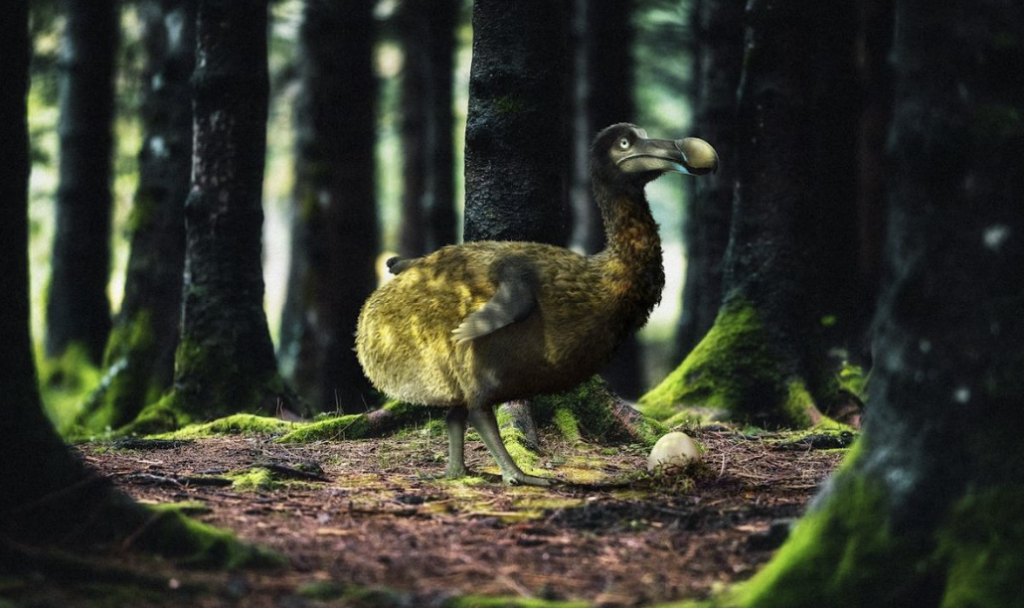Colossal Biosciences is adding the famously dead bird to its de-extinction agenda… Yes, the billion-dollar startup wants to bring back the dodo and the wholly mammoth to life. They plan to re-incarnate the mammoth within the next 4 years… This actually means 5 years until the black market for Dodo/ Mammoth Meat and Mammoth Ivory becomes a thing…

A biotechnology startup that promises to resurrect woolly mammoths within the next 4 years is now the first “de-extinction unicorn,” with a valuation said to be over a billion dollars before bringing back a single lost species. Colossal Biosciences, the Dallas-based startup, is making public a new round of investment this week that will help fund its effort to bring back perhaps the most famously extinct animal of them all: the dodo.
Reintroducing mammoths to Alaska or dodos to Mauritius sounds unrealistic, even silly, and has drawn skepticism from paleo-geneticists and other experts who worry that the effects of de-extinction would be unpredictable. Yet Colossal has continued to draw support from investors, including celebrities, and on Tuesday announced another $150 million for a total of $225 million since 2021. A person familiar with the company said with the latest round the startup is valued at about $1.5 billion.
For some investors, a live dodo is less important than the scientific breakthroughs generated in the push to de-extinction. “Along the lines of being able to bring a species back, we’re going to learn things we can’t learn in a wet lab,” said Thomas Tull, a tech investor who produced the movie Jurassic World and made money investing in scrubs company Figs. His United States Innovative Technology Fund led the latest round. “When you’re doing big things like this, who knows what you’re going to discover along the way.”
The influx of cash comes as the financial world has taken a new interest in the biodiversity crisis. The United Nations conference on biodiversity in December 2022 attracted representatives from Wall Street, and global banks are dabbling with “debt-for-nature” swaps that would protect vulnerable ecosystems in exchange for renegotiating sovereign debt in developing nations. Colossal is positioning itself as a solution to the damage done to the natural world and co-founder Ben Lamm says we have the opportunity to reverse human-inflicted biodiversity loss.
Just how the restoration of long-dead species would pay off for investors is an open question. Colossal has already spun off a software company that raised another $30 million, with Colossal’s investors receiving the equity in the new firm. The company suggests other promising areas for future spinoffs might include gene editing and artificial wombs.
Company insiders regularly bring up the space race when discussing the company’s prospects as an example of a seemingly-impossible goal that was not only eventually reached but also generated collateral inventions that we still use today. “What’s nice about these extinct species is they are systems problems,” said Lamm in an interview. Solving a systems problem requires innovation in multiple areas — and therefore creates breakthroughs that can lead to more spinoffs. “It’s like the moon landing. That was a systems problem.”
Lamm, who co-founded Colossal with Harvard University geneticist George Church, also believes that Colossal’s moonshot-level goal gives the company a competitive edge on recruiting people who would rather research vanished beasts than less exotic projects. “You can work on yeast or you can work on bringing back an extinct species,” he said.
The dodo is the third vanished animal on Colossal’s de-extinction to-do list. In March the startup said it would bring back the woolly mammoth, and in August added a pledge to resurrect the Tasmanian tiger, or the thylacine, which was declared extinct in the 1930s. The company says it’s on track to produce mammoth calves by 2028.
The steady stream of announcements has captivated a collection of celebrity investors, including Paris Hilton and motivational speaker Tony Robbins, who don’t necessarily confer an aura of scientific seriousness. But Colossal has also enlisted less-famous investors with considerable pedigree, although it is unclear how involved they are.
Strategically, it’s less about the mammoths and more about the capability” to engineer animals and plants, the CIA’s venture capital arm In-Q-Tel said in a September blog post in September when it invested in Colossal.
“They’re solving complex problems, and we’ve been pleased with the progress so far,” said Jim Breyer, an early backer of Facebook who invests in Colossal through his firm Breyer Capital. “Long-term, there will be significant revenue opportunities around sustainability, conservation, and re-wilding.”
Tom Chi of At One Ventures, a founding member at Google X, Alphabet Inc.’s innovation lab, is the only independent member of Colossal’s three-member board of directors. He has made ambitious investments in other difficult endeavors such as Helios Labs, which seeks to extract metals and oxygen from the surface of the moon and Mars.
Chi dismisses the focus on Hollywood investors. “Are they mucking with the way we do the science? No,” he said in an interview. In fact, Chi said, the science behind Colossal was so tough that many of its backers didn’t fully understand it. “It would probably take eight hours to explain to a celebrity.”
Traditional investors remain skeptical about the field. “I think the de-extinction angle might hold promise for scientific discovery, but probably very hard for venture in terms of market, cost and speed to scale,” said Helen Liang, managing partner of Founders X Ventures. “The bigger question is what business values could be unlocked and the justification on the cost of capital in doing that.”
Just getting a dodo sample was a painful undertaking.
Beth Shapiro, the company’s lead paleogeneticist and a professor at University of California, Santa Cruz, has been trying to extract genetic material from the dead bird for most of her career. She’s scraped the inside of dodo skulls and sweated in sugar plantations on the Indian Ocean island of Mauritius, where the last dodo was seen in the 1600s. She finally got lucky with a well-preserved specimen kept in a Danish museum, and Colossal now says it has the only known high-quality, complete dodo DNA.
Resurrecting the bird would be just the start. Shapiro warned that any dodo released into the wild would need to be protected from the predators who wiped them out centuries ago. Small islands off the coast of Mauritius, where giant tortoises have also been reintroduced, could be a good place. “Once we have functional dodos,” she said, “we’ll have to create a habitat that can sustain them.” [Bloomberg, Yahoo]
FUNDRAISING: KEEP STRANGESOUNDS ONLINE!… THANK YOU FOR YOUR HELP! (You will get a gemstone gift for every donation above 50$!)
You should also join my newsletter…YOU WILL LOVE IT…
I recommend following Qfiles for videos, podcasts and a wide compilation of alternative news…
The following links feature products I recommend you to add to your preparedness plan to help and protect you and your family during an emergency:
- Protect your home and car with the best lightning and EMP protection available…
- Stock up on iodine pills for the next nuclear disaster…
- Use this filter to drink clean water at home!














Really, instead of bringing back an animal which died of hundreds or thousands of years ago. They should be repopulating or bringing back to more recently extinct or close to extinct creatures, this sounds like a great place you can make bulk money for no production.
T-Rex would be awesome! Turn a couple loose at the next Davos meeting. Get them all at once. I have read stories about folks in the NE region of Australia claiming to have seen a 30′ tall 2-legged reptile step out of the brush and snatch a whole cow. Maybe too much Australian beer. But intriguing. 🙂
Velociraptor
That story is about the Bunyip
https://en.wikipedia.org/wiki/Bunyip
It was to scare people off from going into certain areas and to make sure kids don’t go running off. If you tell them that a croc or snake might get you, then they won’t worry as much. Aussie’s also like to tell tourist that, just as a prank and that they won’t venture into secret spots which are the best for holidaying.
Ok, never heard of that one. Thanks.?
Modern science has the whole world thinking like Jurassic Park. Those animals, the big ones, were up to 1500 year old! That is how (the ONLY way) they got so big. You see, the world was much different before the flood.
There was a complete canopy of ice surrounding the globe which was held up by the atmosphere. So ambient air pressure was 3 or 4 fold what it is today and Oxygen was much more abundant. This was why plants and animals not only grew much bigger but lived much longer.
The T-Rex in Jurassic Park, had it been accurate to the truth, would have been a cute little guy perhaps only a few years old and HARMLESS to humans – ok, maybe he could deliver a painful bite but not much more. Modern science claims full size occurs at age 19 and that one of the creatures, Sue was estimated to have lived to 28 years old and was the oldest recorded T-Rex ever found.
Let us examine that. If modern Crocodilians live up to 75 or 100 years on our much different earth, how likely would it be that a monstrous T-Rex would have lived only 28 years? Mankind lived up to 969 years (Methuselah, the oldest man recorded in the Bible lived 969 years) and reptiles are some of the longest living animal kinds, well, you make the judgement.
All of science must defend its religion of Darwinism and neither the Flood of Noah nor 1500 year old reptiles fit that bill. We have been lied to about our origins and the origins of our earth. The promoters of these lies go to any and every extreme to defend Darwinism even dumping barges of skeletons of giants found prolifically throughout the states in the early part of the 20th century. Many books could be written with the information about the lies we have been sitting under and so I wrote one. All of my research was vetted and confirmed by two or three sources.
Were you aware that in Siberia, frozen Mammoths were found, many of them standing up. They were exceptionally well preserved with skin, even hair being found on them and had food in their mouths and stomachs preserved in a partially digested state. In one field, over 10,000 Mammoths were found frozen in this manner! What could freeze an animal bigger than the size of an elephant so quickly that food in their mouths, esophagus’ and stomach contained plant material in such a preserved state that the plant species were identifiable?
All of these questions can be answered by the canopy of ice falling and the coldness of outer space falling with it (near absolute zero) and filling large areas where these animals lived and roamed and this is the ONLY logical explanation for such massive freezing of fields of Mammoths. So much more can be learned about this and some of it can be seen in my book “Evolution: Fact or Fallacy” Jeremiah C Maddox (my pseudonym) Just search it online. It’s on Amazon, B&B and many other bookstores. Not trying to sell my book here, just trying to wake people up to the truth – a VERY rare commodity in this age.
Never liked Darwinism either. ?
Bring back some Tyrannosaurus Rex so they can eat the commies and satanists.
I’ll buy that for a Dollar!
Seriously…I will pay for that to happen…but won’t the T Rex get a stomach ache???
Yeah, probably. However once he starts pooping there won’t be a fertilzer shortage.